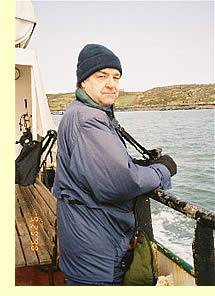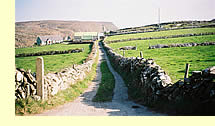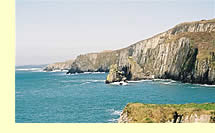





COUNTY CORK, IRELAND

A CLEAR VIEW
 County Cork is the southwestern corner of Ireland, which is itself on the outer edge of the European Union, a distant counter-balance to sunny Greece far off to the southeast. As you reach the end of the mainland in Cork you come to the small harbor at Baltimore and from there you take a doughty little ferryboat to the islands further west. The boat that connects Clear Island to the mainland is the Naomh Ciarabn II. We went his way one spring morning, with a cool breeze off the still-cold ocean. And we reached Clear Island, the most southwestern inhabited spot in Ireland. Barely inhabited, with fewer people than cows.
County Cork is the southwestern corner of Ireland, which is itself on the outer edge of the European Union, a distant counter-balance to sunny Greece far off to the southeast. As you reach the end of the mainland in Cork you come to the small harbor at Baltimore and from there you take a doughty little ferryboat to the islands further west. The boat that connects Clear Island to the mainland is the Naomh Ciarabn II. We went his way one spring morning, with a cool breeze off the still-cold ocean. And we reached Clear Island, the most southwestern inhabited spot in Ireland. Barely inhabited, with fewer people than cows.
On the trip out we found ocean birds: Black Guillemot (known as a "tystie"), Great Cormorant, Herring and Greater Black-backed Gulls near the mainland. As we got into deeper waters west of Sherkin Island we began to see Common Murre, diving Gannet and small floats of Shag. As you pass along Clear Island's cliffs you see the field pattern outlined in stone walls built up over centuries of farmers walking the land, removing the rocks that work their way to the surface. After forty-five minutes at sea we pulled into the tiny harbor on the north side of Clear Island. There a few buildings overlook the short cement pier. A plain white building houses the Clear Island Bird Observatory. There's a combo store, pub, and coffee house. A little wooden shack houses the lone pottery store. A couple fishing boats were tied to the pier. The ferryboat brought six passengers this time, the morning papers, thirty bags of fertilizer, another dozen of cattle feed plus one large bag of seed potatoes. That latter cargo was redolent of the long intertwined history of Ireland and the spud.
 The little harbor is faced on one side by steep cliffs but is nestled into a gently rising cleft in the island, a narrow neck of land making it only a ten minutes walk across to an even larger inlet on the south shore of the island which is three miles along its east-west axis. In the cleft, protected from the wind by the high rising fields and low-lying stone walls are a few lush gardens. There are even a few trees, almost entirely missing from the rest of the island. Here the newly arrived Chiffchaff and Willow Warblers and over-wintering Stonechat and Robins chased insects and one another. Also around the houses and the gardens here were the usual city birds: Blackbirds, Great and Blue Tits, Greenfinches, Chaffinches. Jackdaws lined each roof top, eyeballs trained on anything that moved or looked interesting. When we had our lunch at a picnic table behind the store, a pair of pushy Robins came down the stone cliff and demanded to be fed. We complied. A Pied Wagtail worked the rocky harbor edge but wouldn't deign to notice our hand-outs. After a Gray Heron landed in the rocky shallows to fish, a self-deceiving Hooded Crow arrived to make sounds like a hungry baby heron. The fisher was not impressed so the Crow soon flew away, empty-beaked, to seek easier pickings around the fishing boats and garbage cans. The Heron eventually swallowed a couple small fry before he too left. One Raven circled the harbour lazily while we ate. Gulls and Shag crossed in the ocean beyond.
The little harbor is faced on one side by steep cliffs but is nestled into a gently rising cleft in the island, a narrow neck of land making it only a ten minutes walk across to an even larger inlet on the south shore of the island which is three miles along its east-west axis. In the cleft, protected from the wind by the high rising fields and low-lying stone walls are a few lush gardens. There are even a few trees, almost entirely missing from the rest of the island. Here the newly arrived Chiffchaff and Willow Warblers and over-wintering Stonechat and Robins chased insects and one another. Also around the houses and the gardens here were the usual city birds: Blackbirds, Great and Blue Tits, Greenfinches, Chaffinches. Jackdaws lined each roof top, eyeballs trained on anything that moved or looked interesting. When we had our lunch at a picnic table behind the store, a pair of pushy Robins came down the stone cliff and demanded to be fed. We complied. A Pied Wagtail worked the rocky harbor edge but wouldn't deign to notice our hand-outs. After a Gray Heron landed in the rocky shallows to fish, a self-deceiving Hooded Crow arrived to make sounds like a hungry baby heron. The fisher was not impressed so the Crow soon flew away, empty-beaked, to seek easier pickings around the fishing boats and garbage cans. The Heron eventually swallowed a couple small fry before he too left. One Raven circled the harbour lazily while we ate. Gulls and Shag crossed in the ocean beyond.
The helpful man at the bird observatory showed us on our map where to look for the Red-billed Chough and we set off. Up the steep hill to west, down narrow stone walled roads. We several times found ourselves steeping aside to avoid the servant of the sprit. It was the Saturday before Easter and the island's lone priest was racing around the lanes in his old beater of a car, trying to encourage his few dozen parishioners to remember their heavenly souls on the big day, Easter. Like all drivers on the island, he would give you a friendly pointing finger wag of greeting as he went past. Not safe to lift a hand from the steering wheel to wave. These uneven, rocky lanes were stingy with their wares - no dust as it was damp. No bits of gravel even as the passages seemed to sit on bed rock. No shoulder and no extra space, no room for two cars to pass. As a walker avoiding a coming car, you stepped carefully into the needling gorse.
 The stone walls were misleadingly gentle in outline, largely dressed in spring green: moss, ferns, grass, berry vines, gorse, heather, dandelions. These rock-hearted hedges were short but dense enough to shelter Winter Wrens and Dunnock. At one point in our walking, Kate and I were frozen in place by the sight of a Dunnock atop his section of stone wall, fiercely eyeing us as intruders. He stood on his place less than five feet from us. He strutted, he glared, he was emboldened by a spring dose of testosterone. Suddenly he flew straight across the road and chased another male Dunnock he found there. Hmm, he probably hadn't even noticed our presence. Earlier we'd seen a melée of three Pied Wagtails in a battling tangle down on the pier, fighting with their feet like roosters. Duelling Dunnock. Warring Wagtails. It's spring jousting season in the world of the small land birds.
The stone walls were misleadingly gentle in outline, largely dressed in spring green: moss, ferns, grass, berry vines, gorse, heather, dandelions. These rock-hearted hedges were short but dense enough to shelter Winter Wrens and Dunnock. At one point in our walking, Kate and I were frozen in place by the sight of a Dunnock atop his section of stone wall, fiercely eyeing us as intruders. He stood on his place less than five feet from us. He strutted, he glared, he was emboldened by a spring dose of testosterone. Suddenly he flew straight across the road and chased another male Dunnock he found there. Hmm, he probably hadn't even noticed our presence. Earlier we'd seen a melée of three Pied Wagtails in a battling tangle down on the pier, fighting with their feet like roosters. Duelling Dunnock. Warring Wagtails. It's spring jousting season in the world of the small land birds.
 On sunny south-facing slopes were violets. Water trickled along every small cleft. Our Chough-hunting directions were to go to the end of the road, ignore the private property sign, beware of the bull and just keep walking until we found the birds. We passed several farms and saw dozens of cattle, one person. There were a couple tractors, some Holstein milk cows which are called Frisians here. They watched us with little interest. Mothers cautiously led their calves away from two strangers on the road. It seemed nearly everything was made of stone: the road, the walls between fields, the barns and houses, the very island itself. We came near the gate and the sign telling us were entering private land and were not welcomed. Just at that moment a swirl of dark birds rose above the western horizon, silently they circled, a small tornado of black wings. A look through binoculars showed drooping beaks.
On sunny south-facing slopes were violets. Water trickled along every small cleft. Our Chough-hunting directions were to go to the end of the road, ignore the private property sign, beware of the bull and just keep walking until we found the birds. We passed several farms and saw dozens of cattle, one person. There were a couple tractors, some Holstein milk cows which are called Frisians here. They watched us with little interest. Mothers cautiously led their calves away from two strangers on the road. It seemed nearly everything was made of stone: the road, the walls between fields, the barns and houses, the very island itself. We came near the gate and the sign telling us were entering private land and were not welcomed. Just at that moment a swirl of dark birds rose above the western horizon, silently they circled, a small tornado of black wings. A look through binoculars showed drooping beaks.
 The birds continued to swirl as I found them in my scope. Several landed, then the entire group scattered over a distant hillside with its sparse grass amid rocks, some of the individuals strolled in the open. Red-billed Chough. Red legs, too. Behind them the island dropped away to the Atlantic. Here chough find what they need for life: cold ocean winds, sparse plant life, steep cliffs, grass kept down by cattle, lots of beetles to eat. Clear Island provides ample deserted buildings and small crevices in the cliffs for safe nesting. Chough heaven. So we watched from the end of the road. We were beyond the last house on Clear Island, the last house in Ireland. We were geographically the last people in Ireland, and they were among the last birds on the land.
The birds continued to swirl as I found them in my scope. Several landed, then the entire group scattered over a distant hillside with its sparse grass amid rocks, some of the individuals strolled in the open. Red-billed Chough. Red legs, too. Behind them the island dropped away to the Atlantic. Here chough find what they need for life: cold ocean winds, sparse plant life, steep cliffs, grass kept down by cattle, lots of beetles to eat. Clear Island provides ample deserted buildings and small crevices in the cliffs for safe nesting. Chough heaven. So we watched from the end of the road. We were beyond the last house on Clear Island, the last house in Ireland. We were geographically the last people in Ireland, and they were among the last birds on the land.
TOWHEE.NET: Harry Fuller, 820 NW 19th Street, McMinnville, OR 97128
website@towhee.net